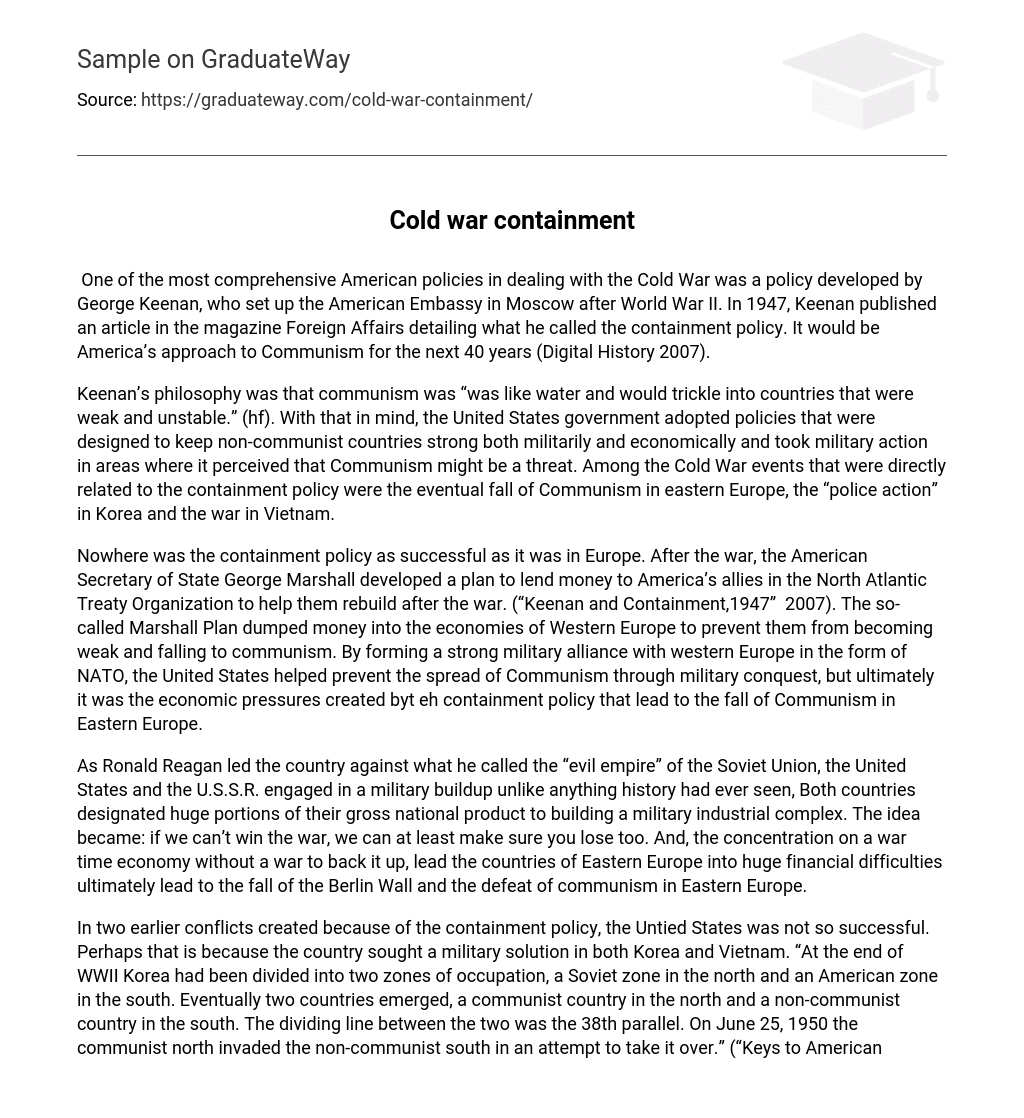One of the most comprehensive American policies in dealing with the Cold War was a policy developed by George Keenan, who set up the American Embassy in Moscow after World War II. In 1947, Keenan published an article in the magazine Foreign Affairs detailing what he called the containment policy. It would be America’s approach to Communism for the next 40 years (Digital History 2007).
Keenan’s philosophy was that communism was “was like water and would trickle into countries that were weak and unstable.” (hf). With that in mind, the United States government adopted policies that were designed to keep non-communist countries strong both militarily and economically and took military action in areas where it perceived that Communism might be a threat. Among the Cold War events that were directly related to the containment policy were the eventual fall of Communism in eastern Europe, the “police action” in Korea and the war in Vietnam.
Nowhere was the containment policy as successful as it was in Europe. After the war, the American Secretary of State George Marshall developed a plan to lend money to America’s allies in the North Atlantic Treaty Organization to help them rebuild after the war. (“Keenan and Containment,1947” 2007). The so-called Marshall Plan dumped money into the economies of Western Europe to prevent them from becoming weak and falling to communism. By forming a strong military alliance with western Europe in the form of NATO, the United States helped prevent the spread of Communism through military conquest, but ultimately it was the economic pressures created byt eh containment policy that lead to the fall of Communism in Eastern Europe.
As Ronald Reagan led the country against what he called the “evil empire” of the Soviet Union, the United States and the U.S.S.R. engaged in a military buildup unlike anything history had ever seen, Both countries designated huge portions of their gross national product to building a military industrial complex. The idea became: if we can’t win the war, we can at least make sure you lose too. And, the concentration on a war time economy without a war to back it up, lead the countries of Eastern Europe into huge financial difficulties ultimately lead to the fall of the Berlin Wall and the defeat of communism in Eastern Europe.
In two earlier conflicts created because of the containment policy, the Untied States was not so successful. Perhaps that is because the country sought a military solution in both Korea and Vietnam. “At the end of WWII Korea had been divided into two zones of occupation, a Soviet zone in the north and an American zone in the south. Eventually two countries emerged, a communist country in the north and a non-communist country in the south. The dividing line between the two was the 38th parallel. On June 25, 1950 the communist north invaded the non-communist south in an attempt to take it over.” (“Keys to American Involvement” 2007). The American government in power at the time viewed all Communists as the same and kept expecting the Chinese Communists to join the war. The stalemate lasted for several years with the Korean War ending with the situation exactly as it had been in the beginning. The communists held North Korea and the country was divided at the 38th parallel. The only difference was that the DMZ, demilitarized zone, along the 38th parallel was formalized and the future of the two nation’s as separate entities seemed secured.
Americans had barely returned from Korea when international scholars began paying close attention to the conflict in Vietnam. Vietnam had long been one of the Indo-China provinces of France and for nearly 100 years, local residents had been fighting for freedom from colonial rule. But when the French decided to leave Vietnam, it appeared that Communist forces would gain strength there and in accordance with the containment policy, the American government sent in soldiers to keep it from happening. Better yet, by this time, President Harry S. Truman had developed the Truman Doctrine. Though it officially referred only to military actions in this hemisphere, he extended the principal to Vietnam. (“Keys to American Involvement” 2007).
The Truman Doctrine stated that the Untied States would support any country attempting to be free. This was originally adopted to attempt to prevent the rise of Communism in central and South America, but by the early 1960s, it was being applied to Southeast Asia. Those who supported the policy began arguing that if we allowed Communism to get its foothold in one country, then one after another would fall to communism. This philosophy, also called the Domino Theory, was likewise very popular during the Cold War (“Keys to American Involvement” 2007).
In the end, the only real success of the containment policy came from economic pressures not military ones. By stressing the economy of Eastern Europe to its breaking point, the United states was able to topple Communist regimes there and eventually watch the fall of the Soviet Union.
WORKS CITED
“Containment” <http://www.hfienberg.com/irtheory/contain.html>, July 29, 2007.
“Keenan and Containment, 1947” U.S. Department of State <http://www.state.gov/r/pa/ho/time/cwr/17601.htm., July 29, 2007.
“Keys to American Involvement in the Vietnam War” <http://www.11thcavnam.com/education/containment&doctrine.htm>, July 29, 2007.
“Postwar America:1945 to 1960”, Digital History, <http://www.digitalhistory.uh.edu/database/article_display.cfm?HHID=485>, July 29, 2007.





